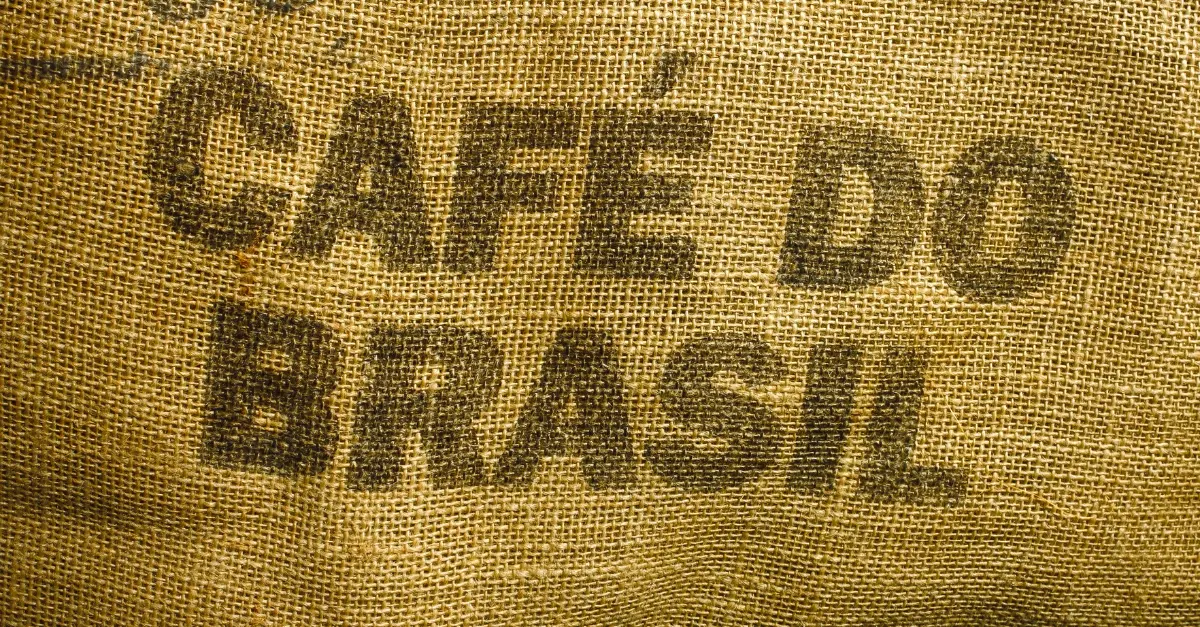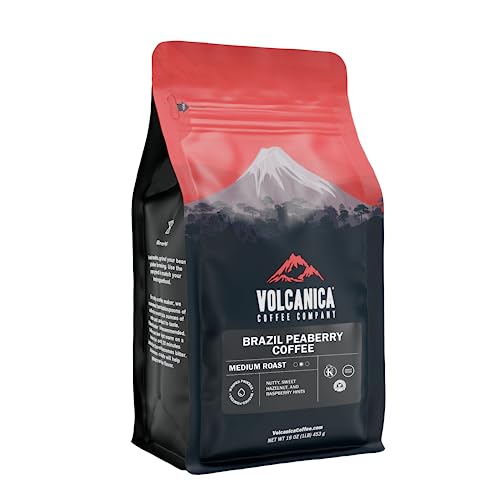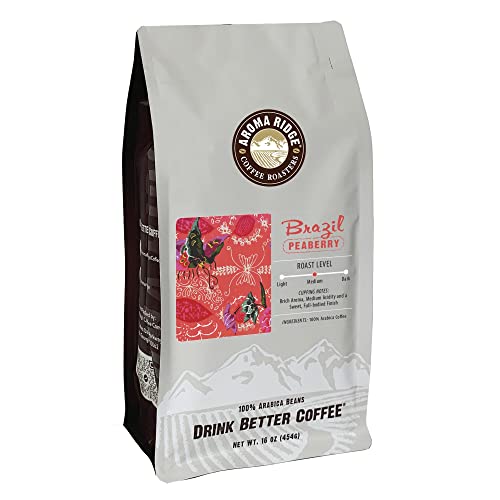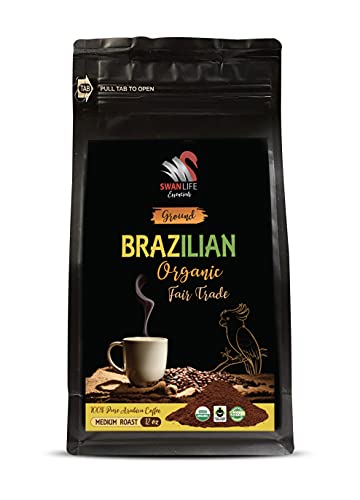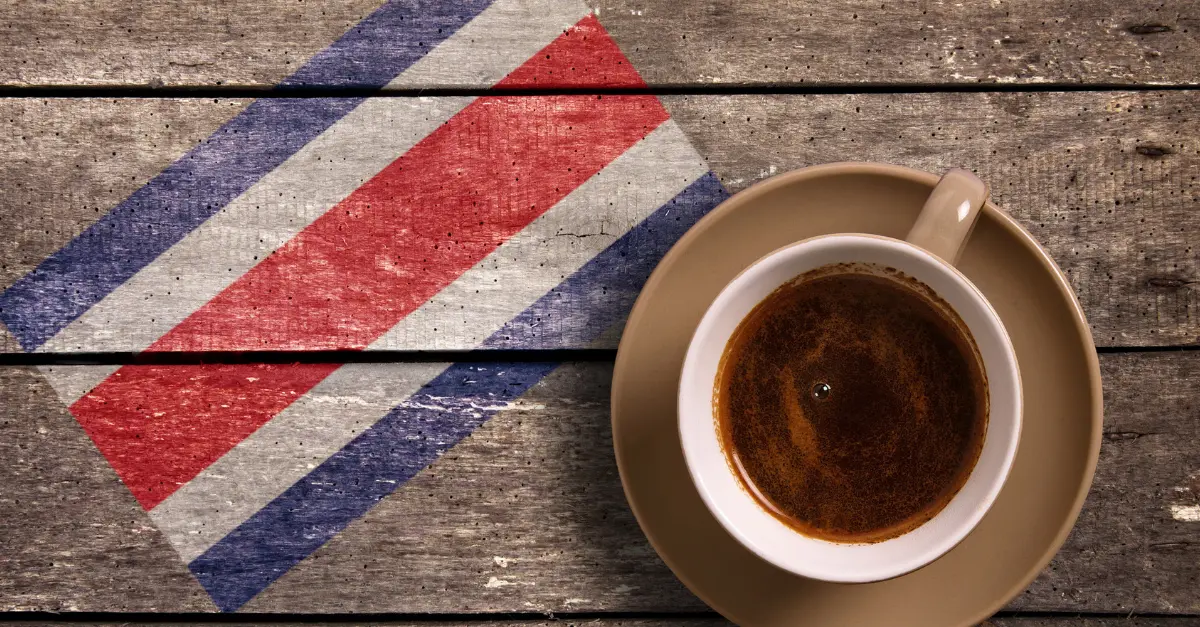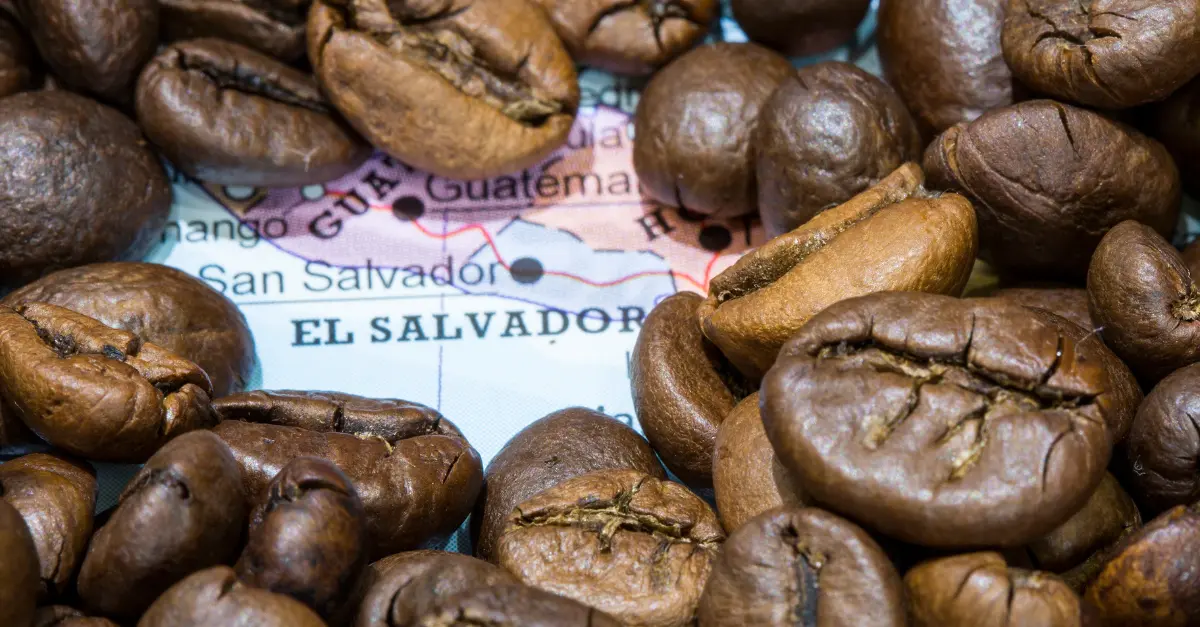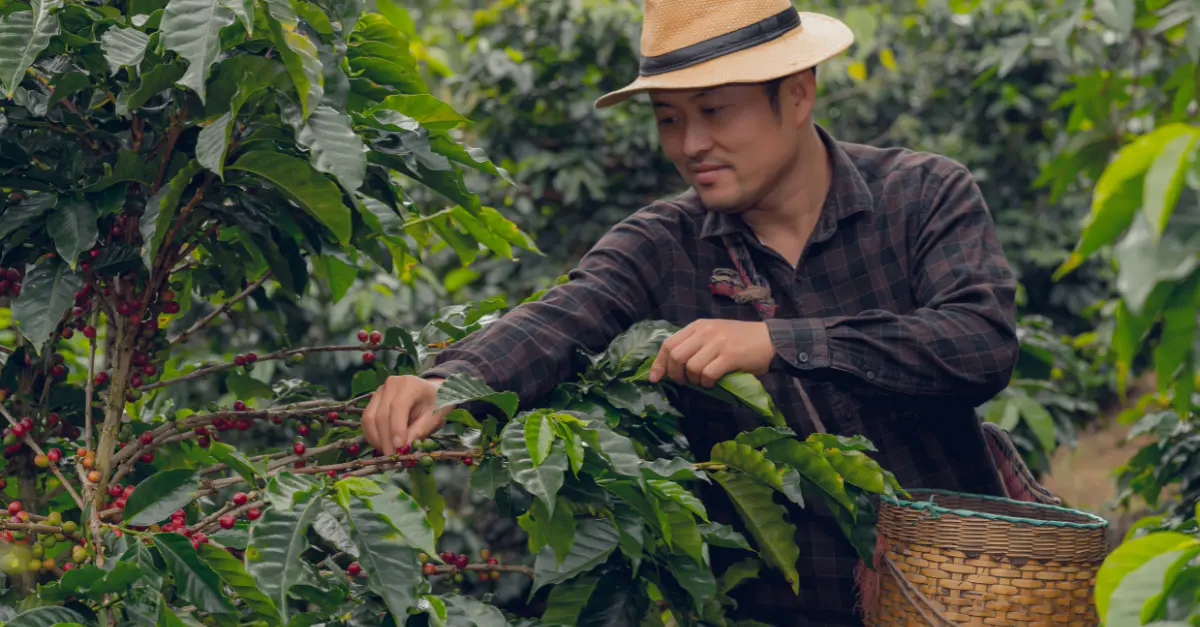Are you wondering what it takes to be the world’s largest producer and exporter of coffee? Taking an in-depth look into Brazilian coffee beans can give you a better understanding of these global best-sellers. When it comes to the world of coffee, brail is undoubtedly synonymous with this treasured bean.
Accounting for one-third of the world’s global coffee supply, Brazilian coffee has a mighty story behind it. Nevertheless, for many coffee lovers, the question remains, why is Brazilian coffee so popular, and how is it different from other regions?
This detailed guide into the world of Brazilian coffee beans shares everything there is to know about this part of the coffee belt region and more. You’ll even find a few top-notch recommendations for when you want to try this famed Latin American coffee.
Try the Best Brazilian Coffee Beans on the Market Today!
As pointed out earlier, Brazilian coffee beans make the best espresso. However, you can experiment with various beans to create specialty drinks, such as cappuccinos and lattes. During the warm summer, these beans also make a killer cold brew. Here are some of the best and most interesting Brazilian coffee bean options to get you started.
Like most coffee-growing regions, Brazil boasts its unique coffee-based drinks. As the world’s largest coffee-producing country, Brazil needs a solid coffee-drinking culture. Sure, you will find locals sipping coffee, school kids receiving packets for their families, and even the government banning coffee imports. But, the coffee culture isn’t as strong as in places, say the U.S.
Brazil still boasts interesting coffee-based drinks like the Cafezinho and Café com leite. Cafezinho refers to a small and filtered cup of piping hot coffee. The coffee offers a bold and intense flavor but should not be compared with the pressurized taste of espresso. The Brazilian version of a latte, café com leite, is commonly drunk during breakfast. However, it uses Cafezinho instead of espresso and is added with hot milk.
Featured Products
Orfeu Special Coffee Intense Roasted Beans
⭐ 4.7/5
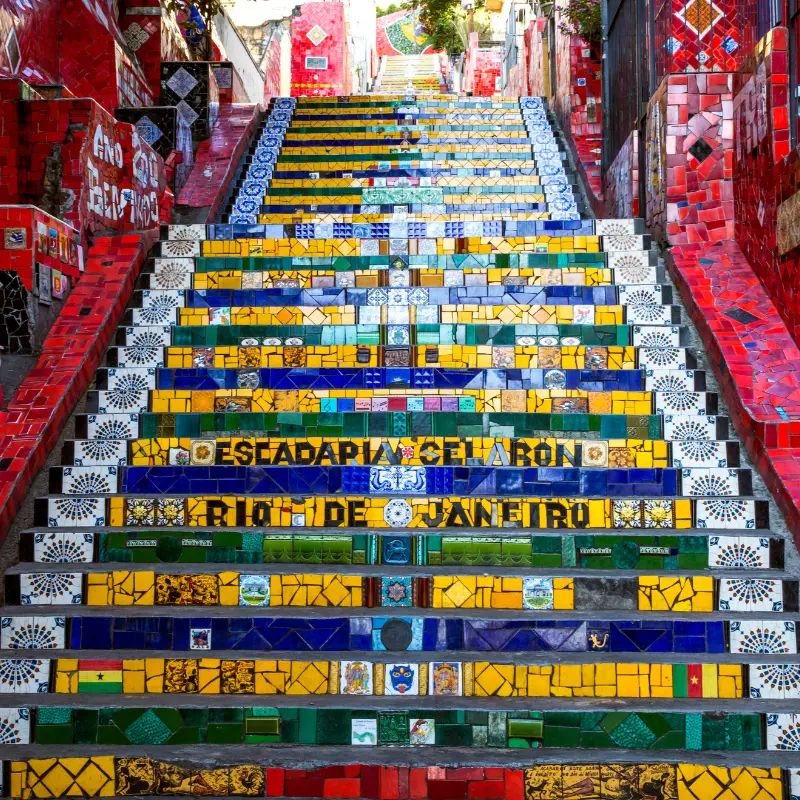
Orfeu Special Coffee provides an intense, dark roasted flavor from 100% arabica beans, perfect for home use.
Pros:
- Delivers an intense dark roast flavor
- 100% arabica beans ensure high-quality taste
- Well-balanced taste profile
- Invigorating aroma that delights senses
- 250g package is ideal for home use
Brazil Peaberry Coffee Whole Bean
⭐ 4.2/5 • 💰 ~$19
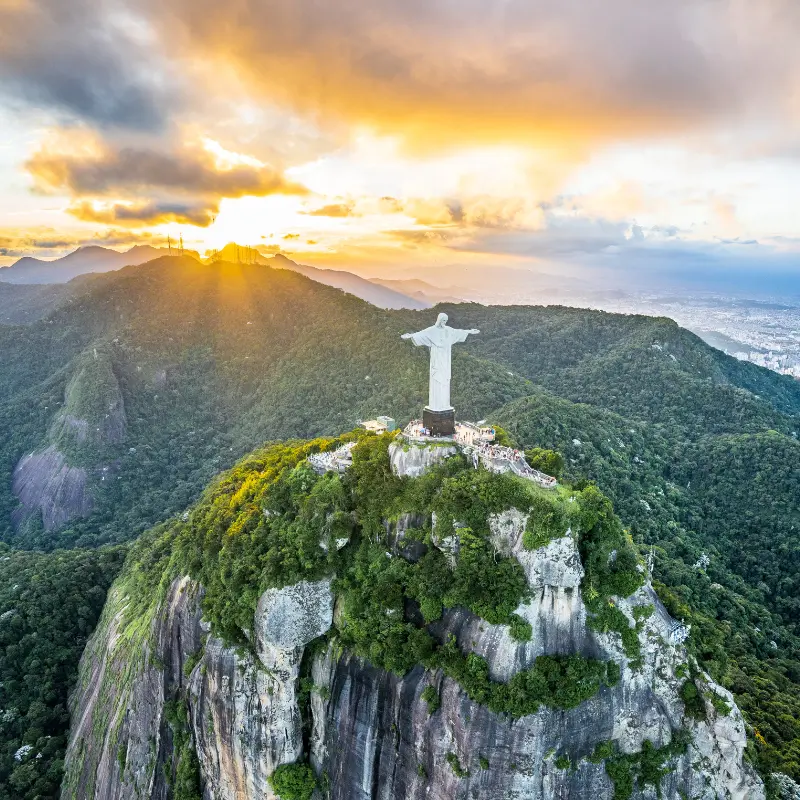
Fresh, flavorful Brazil Peaberry Coffee Whole Bean, perfect for everyday morning brew.
Pros:
- Freshly roasted for premium flavor
- Brazil Peaberry variety offers unique taste
- Whole beans for versatile brewing options
- 16-ounce package provides generous quantity
Aroma Ridge Brazil Peaberry Coffee Beans
⭐ 4.3/5 • 💰 ~$20
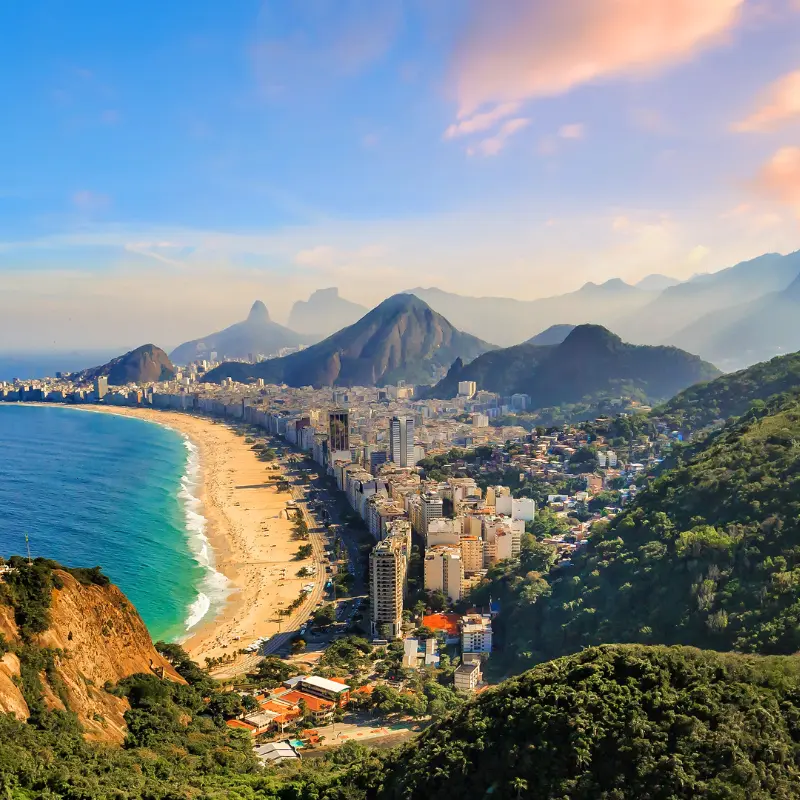
Aroma Ridge Brazil Peaberry is a top-of-the-line coffee, offering a rich aroma and smooth taste. Available in a 16oz package.
Pros:
- Delivers a vibrant aroma
- Has a smooth taste
- Provides a good amount of quantity
- Represents a fine quality coffee
Brazilian Ground Coffee Organic Medium Roast
💰 ~$18
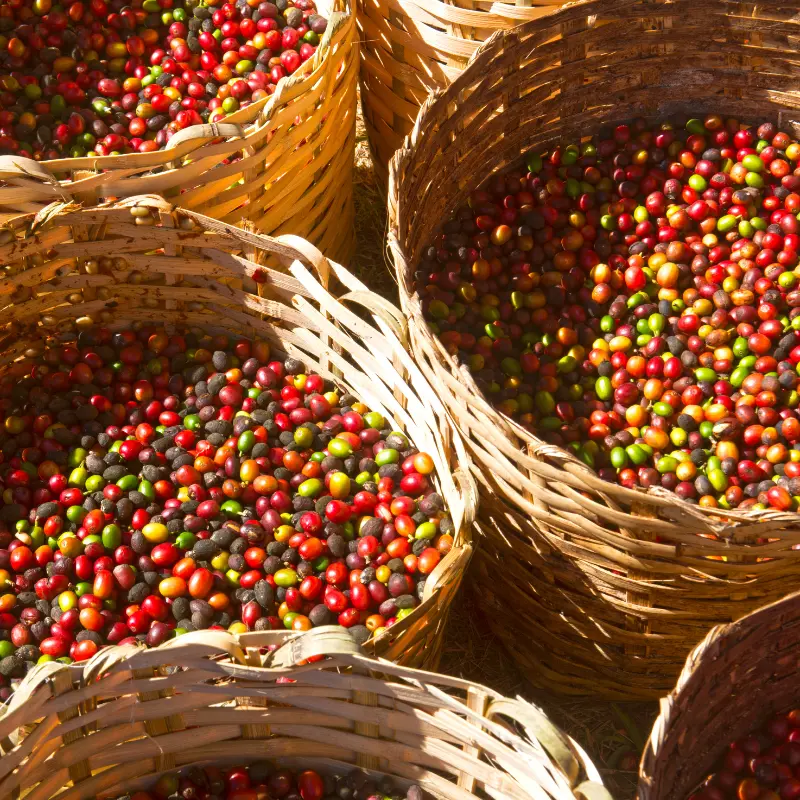
Organic Brazilian coffee, medium roast, low acidity, fair trade and non gmo - a perfect gift.
Pros:
- It’s made from 100% Arabica beans
- It has a smooth, low acidity flavor
- It’s Fair Trade certified
- It’s a non gmo product
- Perfect as a gift
Why is Brazil the Largest Producer and Exporter of Coffee?
Brazilian coffee became the largest producer and exporter through a series of factors. It’s worth examining the entire background story to understand how this truly happened. Nonetheless, the availability of land, immense labor, and the government’s interest in the crop have played a significant role.
Brazilian Coffee Origins
Coffee was first planted in Brazil in 1770 in Rio de Janeiro. Before this time, coffee was never produced in Brazil. Instead, the beans came from French Guiana through a funny story. According to various accounts, a Brazilian soldier, Sergeant Major Francisco de Melo Palheta, visited Cayenne in French Guiana to discuss land-related issues with French Guiana’s then-governor or mayor.
However, during his diplomatic visit, he seduced and had an affair with his wife. Upon his departure, he asked his host to return some coffee beans to Brazil, but the host refused. Fortunately, his wife gave Palheta coffee seedlings disguised in a flower bouquet.
Once in Brazil, Palheta attempted to plant the coffee in the northern Para state. But, the results could have been more impressive. It was not until more than four decades later, when the plants were introduced in the southern regions near Rio de Janeiro and a harbor town in Sao Paulo known as Santos, that the plants began to thrive.
With the first planting of coffee beans, the crop spread across the northern and southern regions across many plantations. In less than a century, coffee production in Brazil rose to 5,500 tonnes annually. The mass land Brazil offers also made mass production easy. Brazil occupies about 5.6% of the total world’s land. Moreover, mass production was further fostered by the increased demand for coffee in the United States and Europe during the early 19th century.
Further boosting coffee production in Brazil was the mass emigration of Asian immigrant workers in the 19th century. During this time, a severe disease ravaged many Asian coffee farms, leading to this mass exodus to Brazil’s coffee production industry. During this time, coffee production became industrialized in the country, and Brazil claimed its position in the global center stage as the number 1 producer!
But, it would be unrealistic to avoid acknowledging factors such as the availability of free labor during the slavery period. Brazil, as a country, was built on the grind, exploitation, and enslavement of indigenous and people of African descent. Brazil held nearly half of the 12 million people of African descent brought to the Americas between 1540 and 1860s.
For the duration of this trade, enslaved people were the very heart of the economy of Brazil. The arduous and aggressive demands on enslaved people helped Brazil rapidly grow as a prominent coffee exporter. This is because these conditions made it easier to achieve an industrial approach in sugar cane, coffee, and other typical crops farmed in Brazil.
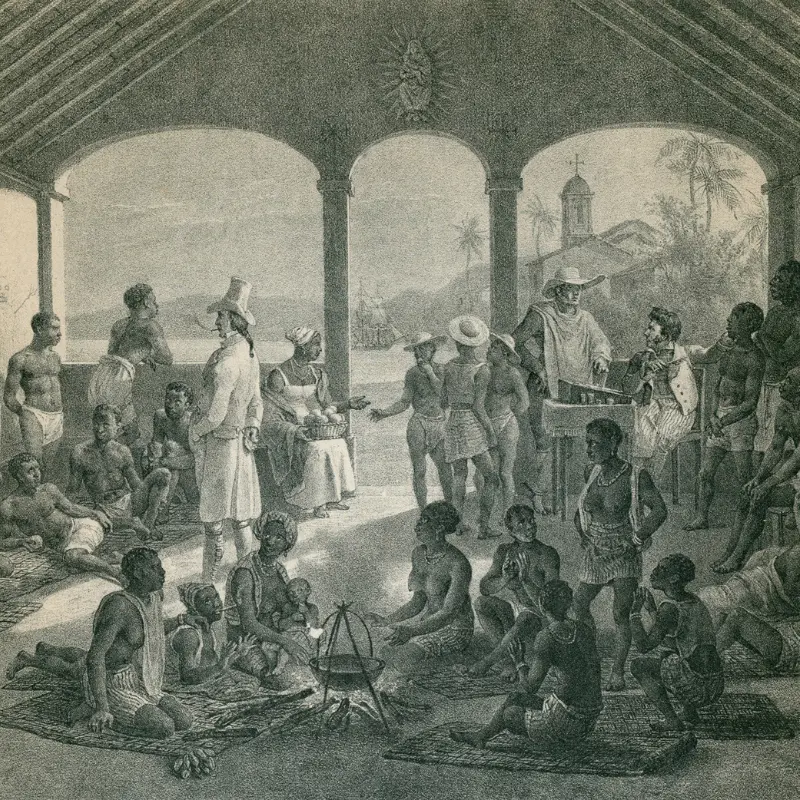
By 1888, slavery was abolished. But, at this time, the sector was stable and already established through more industrialized and modern (at the time) means. Further, the Brazilian government put impressive efforts into boosting this market.
Another factor that prevented Brazilian coffee production from faltering after the abolition of slavery was increased immigration in the country. This, in turn, meant more labor and human capital for the country. So, many coffee plantation owners began using European immigrants to fill their labor demands.
Significant industrialized improvements were made during this time, including constructing the railway system. This made it easier to haul oversized freight into port cities for exports. The railway system also made it easier for the large labor pool to travel in search of jobs. Moreover, plantations had a fair share of labor to pick from, including freed slaves and Spanish, Italian, and Japanese immigrants.
Since its mass production, coffee production has seen two significant booms. The first boom was between the 1820s and 1840s when Brazil’s coffee global market share rose from 20% to 40%. This boom resulted from the significant demand in the USA and Europe.
The second boom came between the 1880s and 1920s. This boom resulted from the government’s significant support for the sector. It is safe to say that Brazil’s centuries of coffee production have indeed shaped its landscape, economy, society, and culture! After all, the growing coffee industry transformed cities such as Sao Paulo from small towns into large industrial cities.
While Brazil has remained a powerhouse of coffee production to date, it has experienced its fair share of troubles. These include the decline of demand during the 20th century, exacerbated by the Great Depression. This, in turn, led to the plummeting of prices and increased stock stuck in Brazil. Nonetheless, the country and its economy recovered, including burning and dumping over 78 million bags (60kg) of coffee in the ocean in a futile effort to raise demand and prices. The government also championed agreements to prevent this from ever happening again. This is how the ICA, International Coffee Agreement was founded.
Further, Brazil is responsible for the formation of multiple world-class coffee competitions. These include the Cup of Excellence Competition, launched in 1999. The primary purpose of this competition is to find, promote, and recognize their country’s quality coffee.
As a result, the event doesn’t only help to enhance recognition among coffee lovers globally. It has also helped to encourage buyers to pay more for quality coffee and to improve the state of coffee production as farmers strive to produce the best. After all, the best earns you more.
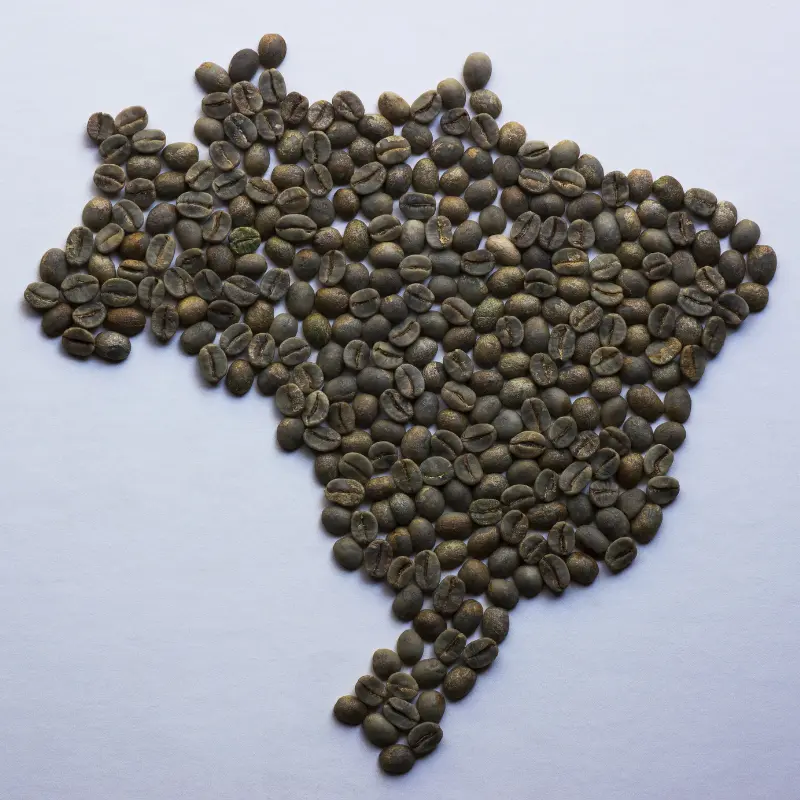
Key points:
-
Origin of Coffee in Brazil: Coffee first planted in Brazil in 1770 in Rio de Janeiro.
-
Growth of Coffee Production: Initial attempts to plant coffee in northern Para state were not very successful. Coffee spread across Brazil, with production reaching 5,500 tonnes annually within a century.
-
Labor and Industrialization: Asian immigrant workers migrated to Brazil in the 19th century due to diseases in Asian coffee farms. Brazil’s coffee production became industrialized, making Brazil the top global producer. Brazil’s economy heavily relied on the labor of enslaved indigenous people and people of African descent. Infrastructure, like the railway system, was developed, aiding in transportation and labor mobility.
-
Booms in Coffee Production: First boom (1820s-1840s): Brazil’s global market share rose from 20% to 40% due to demand in the USA and Europe. Second boom (1880s-1920s): Resulted from significant government support. Coffee industry transformed cities like Sao Paulo into major industrial hubs.
-
Challenges and Recovery: Brazil faced a decline in demand during the 20th century, worsened by the Great Depression. To counteract falling prices, Brazil dumped over 78 million bags of coffee into the ocean. The International Coffee Agreement (ICA) was established to prevent such crises.
-
Recognition and Competitions: Brazil initiated world-class coffee competitions, like the Cup of Excellence Competition in 1999. The competition aims to promote and recognize quality coffee, encouraging higher prices for top-quality beans and improving overall coffee production standards.
Brazilian Coffee Today
Today, coffee in Brazil is grown on different farms and plantain sizes. You can find smaller family-run farms with less than 10 hectares to larger plantation estates covering over 2,000 hectares. From time immemorial, Brazil’s vast land and unique terrain have allowed for mass coffee production.
Typically, Brazil boasts large, uninterrupted land that can be set aside for coffee farming. This makes care, maintenance, irrigation, and harvest more accessible and mechanized. Therefore, Brazilian coffee farmers can produce more coffee with less effort than other coffee-growing countries in the coffee belt region.
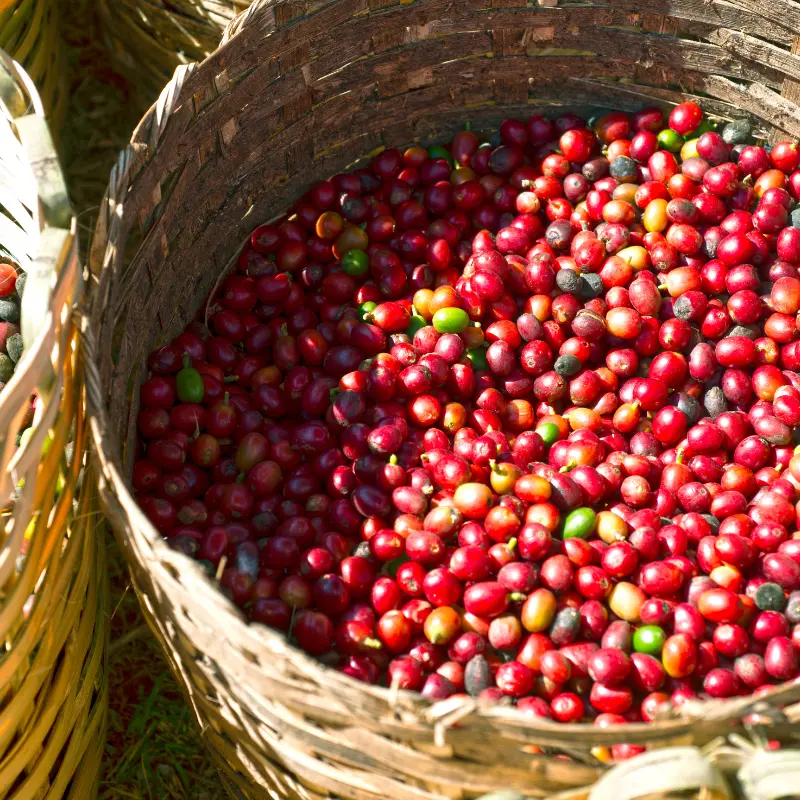
Brazilian Coffee Facts
- Brazil accounts for a total of one-third of the global coffee production and export
- Brazil is the largest producer of Arabica coffee in the world (40%)
- Brazil is the second largest of Robusta coffee (24.6%)
- 70% of the coffee grown in Brazil is Arabica Coffee
- Brazilian coffee is grown in 7 key states, including Minas Gerais, Espírito Santos, São Paulo, Parana, Rio de Janeiro in the South and Rondônia and Bahia in the North.
- Minas Gerais is the largest arabica coffee-producing region in Brazil
- Coffee grows in altitudes of 1,800 (550m) and 3,600 feet (1100m).
- Espírito Santo and Rondônia are the largest robusta coffee producing regions
- Coffee farms and plantation estates cover over 2 million hectares of Brazilian land
- Coffee harvest season is between April and September
- An estimated 66 million bags of coffee (60kg bags) are expected to be produced in the 2023/23 calendar
- The coffee industry employs over 3.5 million people in Brazil
- The Brazilian government has outlawed raw coffee imports, so coffee in Brazil is exclusively Brazilian.
What Type of Coffee Grows in Brazil
Arabica and Robusta coffee beans are Brazil’s primary commercial coffee varieties. But, you can still find a few plantations experimenting with lesser-known varieties, like Liberia or Excelsa. The arabica variety dominates the market, accounting for 70% of the total production.
While other regions grow the variety, the southeastern state of Minas Gerais accounts for most of the arabica coffee beans grown in Brazil. On the other hand, the southeastern state of Espírito Santo and, recently, the northwestern state of Rondônia are the largest producers of robusta coffee beans.
Brazilian Arabica Coffee Beans
Typical arabica coffee varieties grown in Brazil include bourbon, Catuai, Acaia, Mundo Novo, and Icatu.
| Coffee Bean Variety | Description | Taste Profile |
|---|---|---|
| Yellow and Red Bourbon Arabica | One of the two main Arabica coffee cultivars. Grown across the coffee belt region, especially in Brazil. | Intoxicating aroma with rich chocolate notes. Medium and well-balanced body. |
| Red and Yellow Catuai Arabica | Unique and rare arabica cultivar developed in Brazil. Hybrid between Mundo Novo and Red Caturra. | Sweet taste profile with varying notes. Good balance between acidity and richness. Ideal for ultra-creamy and smooth espresso. |
| Mundo Novo | Arabica coffee bean varietal from Brazil. Natural cross between bourbon and Typica arabica. | Rich body with a sweet taste, reminiscent of raisins and caramel. |
| Peaberry | Accounts for only 5% of the overall harvested coffee in Brazil. | Exemplary balance of sweetness and acidity. Rich body with pleasant flavor blends. |
Yellow and Red Bourbon Arabica Coffee Beans
Bourbon is one of the two main Arabica coffee cultivars (with the other one being Typica). Grown across most countries in the coffee belt region, you can find both red and yellow bourbon cultivars in Brazil. Red and yellow Brazilian bourbon arabica coffee beans are mostly rated as gourmet. These beans achieve an intoxicating aroma with rich chocolate notes. They also offer a medium and well-balanced body.
Red and Yellow Catuai Arabica Coffee Beans
Catuai is a unique and rare arabica coffee bean cultivar with a sweeter taste. As the Portuguese-sounding name may have suggested, this high-yield cultivar was developed in Brazil. This cultivar is a hybrid between Mundo Novo and Red Caturra (a varietal of the bourbon cultivar).
Red and catuai coffee bean varieties boast a sweet taste profile with varying notes based on the lot. They also have a good balance between acidity and richness. If you want to enjoy an ultra-creamy and smooth cup of espresso, these varieties are the best.
Mundo Novo
Mundo Novo is an arabica coffee bean varietal that originates from Brazil. This varietal results from a natural cross between the bourbon and Typica arabica varieties. Mundo novo offers a rich body with a sweet taste, reminiscent of raisins and caramel.
Peaberry
Peaberry coffee accounts for only 5% of the overall harvested coffee in Brazil. This rare coffee bean tends to achieve an exemplary balance of sweetness and acidity. It also boasts a rich body with pleasant flavor blends.

Brazilian Coffee Growing Regions
As mentioned earlier, coffee growing in Brazil spans from northern to southern regions. The crop is officially grown in 14 different areas of Brazil, spread across the seven key states. These include Minas Gerais, Espírito Santos, São Paulo, Paraná, and Rio de Janeiro in the South. The northern states have Rondônia and Bahia.
| Region | Description | Coffee Characteristics |
|---|---|---|
| Minas Gerais | Grows at 2625-4265 feet altitude. Largest coffee-growing land (1.22 million hectares). Produces half of Brazil’s coffee. Cerrado Mineiro region is world-recognized for quality. | Well-defined seasons. Average temperature around 23°C. Higher altitude arabica coffee. Sul de Minas coffee has sweet flavor, light acidity, and rich aroma. |
| Espírito Santo | Second-largest coffee-growing state (433,000 hectares). Located in a mountainous area. | Mostly robusta coffee (about 75%). Used mainly in blends. |
| São Paulo | Third-largest coffee-producing state (216,000 hectares). Alta Mogiana region is known for specialty coffee. | Average temperature 20-22°C. Microclimate for flavor development. Primarily arabica beans from small farms. |
| Bahia | Largest northern state producer (171,000 hectares). Warm climate and high altitudes. | Primarily arabica beans. Chapada Diamantina region offers rich-bodied and floral profile coffee. |
| Rondônia | Fifth largest producer (95,000 hectares). Covered by forests. | Mostly sustainable robusta coffee. Used mainly in blends. |
| Parana | Sixth-largest producer (49,000 hectares). North Pioneer region is key. | Arabica beans. Specialty lots from North Pioneer region. Volcanic soil, moderate rain, and mild climate. |
Minas Gerais
Minas Gerais Coffee grows on altitudes of 2625 feet to 4265 feet in this area while the state covers the largest coffee-growing land (1.22 million hectares) in the country. About half of the total coffee produced in Brazil comes from the Minas Gerais state.
Minas Gerais state, particularly the Cerrado Mineiro region, produces the best coffee in Brazil. The Cerrado Mineiro region is a world-recognized high-quality coffee-producing region. It is the first place to receive the Designation of Region in Brazil or the first protected geographical indication (PGI).
This region is characterized by its well-defined seasons, i.e. hot and wet summers and dry winters. Further, the average temperature in this region is around 23 degrees Celsius/ 73.4 degrees Fahrenheit. This allows for higher altitude growing with mostly arabica coffee varieties harvested.
The southern part of the Minas Gerais state, also known as Sul de Minas, is another prominent coffee-growing area. Sul de Minas is on a steep highland with vast slopes and valleys. Microclimates also complement the site to make it great for growing arabica beans. This area produces distinctive coffee, usually undergoing the washed process after harvest. As a result, Sul de Minas coffee tends to achieve a sweet flavor, light acidity, and pleasantly rich aroma.
Espírito Santo
Espírito Santo is the second-largest coffee-growing state in Brazil, covering about 433,000 hectares of land. Located in a mountainous area, most of the coffee from Espírito Santo is robusta (about 75%). The coffee harvested from this region is mainly used in blends.
São Paulo
Sao Paulo is Brazil’s third-largest coffee-producing state, covering about 216,000 hectares of land. Among the best-rated coffee growing in the Sao Paulo region includes coffee from the Alta Mogiana region. Located in the northeast part of Sao Paulo, the Alta Mogiana region offers the best climate for high altitude and specialty coffee.
The average temperature in the region is also much lower, at around 20 to 22 degrees Celsius/68 to 71.6 degrees Fahrenheit. This region is located in the highlands to offer a microclimate to help coffee cherries to develop the best flavors for longer.
Specialty coffee from the Alta Mogiana region can come from any of the 15 municipalities, including Altinópolis, Buritizal, Batatais, Cajuru, Cristais Paulista, Franca, Itirapuã, Jeriquara, Nuporanga, Pedregulho, Patrocínio Paulista, Ribeirão Corrente, Restinga, Santo Antônio da Alegria and São José de Bela Vista. Unlike in Minas Gerais, most farms in the Alta Mogiana region are smaller. But like Minas Gerais, this region primarily produces Arabica coffee beans.
Bahia
Bahia is the largest northern state producer of coffee and the fourth largest nationally, with up to 171,000 hectares of coffee-farmed land. Bahia offers a warm climate and high altitudes. Primarily growing arabica coffee beans, the state provides two key regions with dozens of municipalities that grow coffee. Offering a unique biodiversity and landscape, the Chapada Diamantina region is among the common Bahia coffee-growing regions.
Growing coffee at a minimum of 3600 feet elevation and low temperatures, the region offers rich-bodied and rich-flavored coffee. Coffee from this region vastly differs from other parts of Brazil, offering a lighter and more floral profile.
Rondônia
Rondônia is Brazil’s fifth largest coffee producer, with land of up to 95,000 hectares. Vastly covered by forests, the northern region produces mostly sustainable robusta coffee. Like robusta coffee from Espírito, robusta from Rondônia is typically used in blends.
Parana
Parana is the sixth-largest coffee-producing region in Brazil, covering about 49,000 hectares. While Parana is a relatively minor coffee-producing region, but it still produces good quality coffee. In particular, the North Pioneer region of Parana has most of its beans. Cities such as Cornelio Procopio, Jacarezinho, Cornelio Procopio, and Maringa are among the key coffee-growing cities in the region.
The area offers volcanic and rich soil complemented by moderate rain and a mild climate for the perfect coffee-producing environment. This state produces arabica coffee beans with most of its specialty lots coming from the North Pioneer region.

The Harvest and Processing of Brazilian Coffee Beans
Brazilian coffee producers have evolved significantly from the very first successful farming in the late 1700s. The 20th-century industrialization saw the introduction of better harvesting and processing techniques to produce even better coffee.
Based on the size and financial capacity of the farm, coffee cherries in Brazil are either handpicked, strip-picked, or mechanically harvested. Strip picking involves stripping the entire cherry tree, no matter the ripeness. The cherries are then laid on a tarp or plastic sheet and sorted.
On the other hand, mechanical harvesting involves the tree shaking to remove the cherries from the branches before the sorting process. Furthermore, the strip and automated harvesting processes can be sorted using machinery at the wet and dry mill to significantly reduce labor costs (for large estates). Nonetheless, most coffee from Brazil is handpicked due to the mountainous landscape that makes using machinery virtually impossible.
Unlike most coffee-producing countries, which use the washed or wet process, Brazil primarily uses the unwashed or natural process. This process involves cleaning whole beans and sun drying for about 8 to 10 days. Through a hulling process, the outer dried berry layer is removed while beans are sorted, graded, and packed – ready for sale or export!
While it has become a practice today, natural processing was chosen due to the water scarcity in coffee-growing regions. Initially, the raw processing could have been more accurate, failing to pick up on defects, such as over-fermentation. But, in the early 90s, Brazil adopted a more precise pulped natural processing for even better quality coffee beans.
Brazilian Coffee Flavor and Profile
Unlike other coffee-growing regions in the Americas, most Brazilian coffee is grown at a much lower elevation. This makes the coffee less dense and less flavorful than higher elevation grown alternatives. Besides crafting espresso blends, many coffee connoisseurs don’t prefer Brazilian coffee to other coffee beverages.
Nonetheless, Brazilian coffee beans still stand out on the global stage. It’s worth noting that as the largest and longtime producer, Brazil has mastered several things in coffee production. First, the land offers a rich and fertile ground, allowing producers to craft the highest standards, quality, and coffee grades while still meeting global demands.
So, if you really want to explore and experience Brazilian coffee, you can find specialty-grade coffee that appeals to your palate, not just the regular espresso blends. Some coffee lovers prefer Brazilian coffee beans for filter brewing due to their delicate flavor – in our opinion, this is among the best ways to enjoy Brazilian coffee!
Different farms and estates yield unique lots based on the land, climate, geographical features, care practices, and processing. But Brazilian coffee also has a standard flavor profile and characteristics.
Specialty Brazilian coffee beans tend to have a milder body and lower acidity than East African coffee. Moreover, Brazilian coffee offers more nuanced flavors than the characteristic fruity and floral East African coffee flavors. Brazilian coffee beans are characterized to have chocolatey, caramel, and nutty flavor notes.
You can find a few varieties with sweeter undertones, while others taste bitter. These pleasant and mild, low acidic flavors make Brazilian coffee beans perfect for sipper coffees, such as espresso or filter brews.
Criticism of Brazilian Coffee Beans
Brazil continues to do an excellent job at capturing the global coffee market, and it doesn’t seem to be fairing off anytime soon. However, many critics claim that more focus is put on quantity than quality in coffee production in Brazil. More is invested in mass production and efficient harvesting with little focus on quality and flavor.
- The typical low-altitude growing environment compared to other coffee-producing central and South American countries. This can lead to speed-up maturation as the cherry isn’t given ample time to develop its flavors fully.
- The sunny climate in Brazil means cherries are exposed to more extended periods of sunlight. As a result, most cherry trees experience premature ripening.
- Monoculture farming significantly reduces biodiversity. Regions such as Asia and Africa practice natural coffee production in most farms. This means that the environment around, including the flora and fauna, thrives while further complementing the growth of the coffee trees. For instance, regions prominent for growing bananas pair them with coffee trees. The banana tree offers soil-fixing properties, while their leaves can act as mulch to insulate coffee trees further. As a result, coffee trees enjoy more access to nutrients and sufficient temperature regulation, respectively. However, in many cases, commercial-focused coffee farming in Brazil doesn’t allow this type of co-existence.
- As mentioned above, Brazil practices three standard harvesting processes. Larger, more commercially based farms practice mechanized harvesting. While this method is sufficient, it does impact the quality. Harvesting using tractors and other mechanized options leads to crude picking as every cherry from the tree is picked. Even with the sorting process after, a few unripe cherries may slip into the lot.
Other critics have even pointed out the pulped dry coffee processing primarily used in Brazil. This process features the drying of the entire bean with the mucilage still one to enhance sweetness.
In addition to the other local factors, the processing helps to harness the characteristics of flavor notes of chocolate, caramel, and nuts with low acidity and mild body. Compared to coffee from Central America or East Africa, these flavors and characteristics are certainly unique. But, they don’t offer the subtle exquisiteness to make them exciting specialty coffee options – or, critics claim!
However, this unique Brazilian coffee profile has contributed immensely to the popularity of Italian espresso – and continues to be a vital component. Espresso comes out best with dark roasts as the flavors are compressed. Unlike brewing options such as filter or drip, espresso doesn’t highlight the individual flavors of the coffee.
The point is to create a dark and creamy beverage. This explains why the sweet and nutty Brazilian coffee beans are ideal – and why blends are used. Both arabica and robusta coffee from Brazil are used in espresso blends. While the arabica variety is used for its flavor, robusta is added for its rich crema and higher caffeine content.
It is said that the milder body and low acidity of Brazilian coffee aren’t as exciting in brewing options, like filter or drip, that highlight the flavors best. Ultimately, experiencing coffee is subjective and entirely depends on the drinker. The best part of Brazilian coffee beans is that the possibilities are endless with such a widespread variety of lots from different regions and farms or estates. You have a myriad of options to try and make your judgment.

Global Climate Change Impact on Brazilian Coffee Beans Today
Like the rest of the world, Brazil has experienced its fair share of the global warming threat. Many studies suggest that arabica coffee farming is more impacted than other varieties. It’s worth noting that coffee production thrives in particular conditions. While arabica coffee is more sensitive to growth, robusta requires suitable needs.
Arabica coffee beans boast a narrow temperature growing range between 64 and 73 degrees Fahrenheit (18 to 24 degrees Celsius). Below 64 degrees Fahrenheit, the conditions become too cold, while temperatures above 73 degrees Fahrenheit can lead to plant damage.
Optimal results are usually achieved at around 64 to 69.8 degrees Fahrenheit. Above this, you may still get a good harvest but will certainly experience a few quality issues. This can only be achieved when the coffee is grown at higher altitudes.
In addition to the suitable temperature conditions, higher elevations experience less rainfall and offer better shade - a set of other important growing factors! Unfortunately, the rising global temperatures impact these factors, leading farmers to move their farming higher to achieve the same conditions. But there’s only so much a farmer can do.
A study has reported that the global impact of climate change predicts that the area suitable for arabica coffee bean farming will reduce by 50% by 2050. It’s worth noting that Brazil accounts for more than a quarter of the global arabica coffee production and supply.

